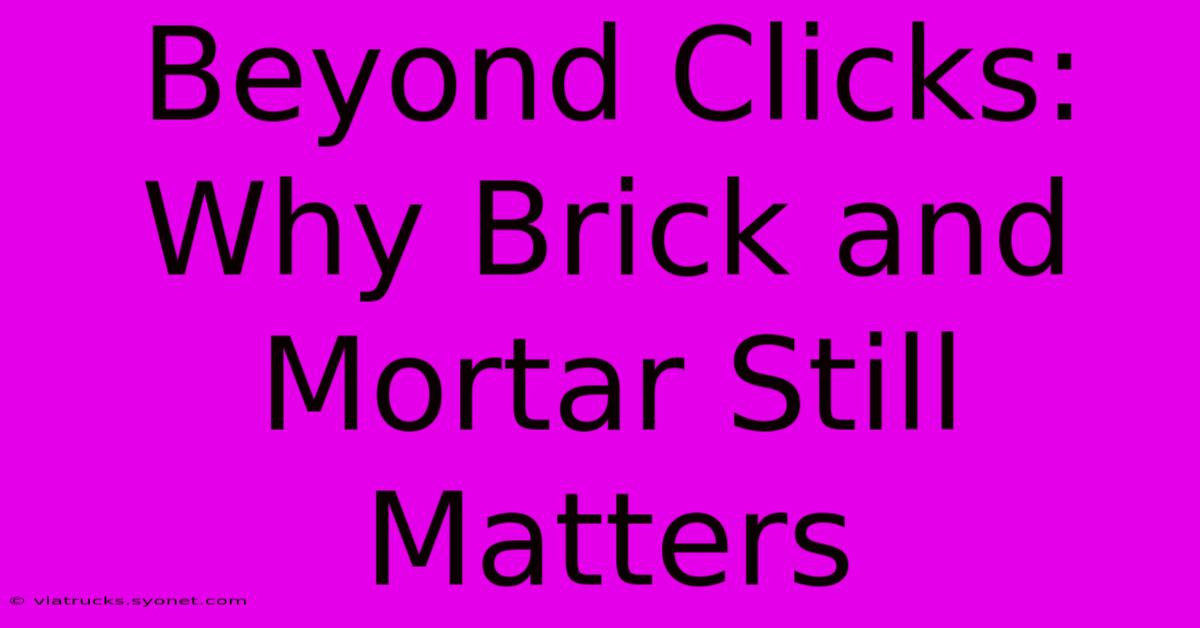Beyond Clicks: Why Brick And Mortar Still Matters

Table of Contents
Beyond Clicks: Why Brick and Mortar Still Matters
In today's digital age, the rise of e-commerce has led many to believe that brick-and-mortar stores are becoming obsolete. However, the reality is far more nuanced. While online shopping offers convenience, brick-and-mortar stores still hold significant value and offer a unique set of advantages that online retailers simply can't replicate. This article explores why the physical store experience remains crucial for businesses and consumers alike.
The Irreplaceable Power of the In-Person Experience
The digital world offers speed and convenience, but it lacks something crucial: the human touch. Online shopping is often transactional; you browse, click, and wait for delivery. But a brick-and-mortar store provides a sensory experience. Customers can:
- Touch and feel products: This is particularly important for items like clothing, furniture, and electronics, where texture and quality are key purchasing factors. Seeing and feeling a product firsthand eliminates much of the uncertainty associated with online purchases.
- Interact with knowledgeable staff: Helpful staff can answer questions, offer personalized recommendations, and provide expert advice – something difficult to achieve through a chatbot or online FAQ.
- Experience the brand: A well-designed store can create a strong brand identity and enhance customer loyalty. The atmosphere, décor, and overall experience contribute to a stronger emotional connection with the brand than a website ever could.
- Enjoy immediate gratification: There's a certain satisfaction in walking out of a store with your purchase in hand, rather than waiting for days or weeks for delivery. This immediacy can be particularly appealing for impulse buys.
Brick and Mortar: More Than Just a Sales Channel
Brick-and-mortar stores are not just places to make sales; they are powerful marketing tools. They serve as:
- Showrooms: Customers can explore products and get a feel for the brand before making a purchase online. This "showrooming" effect can drive online sales by creating brand awareness and familiarity.
- Community hubs: Stores can become integral parts of their local communities, hosting events, workshops, and creating a sense of belonging. This fosters customer loyalty and positive brand association.
- Data collection points: While online retailers track browsing and purchasing behavior, brick-and-mortar stores can gather valuable data through point-of-sale systems and customer interactions, providing insights into customer preferences and needs.
The Synergistic Power of Omni-channel Retailing
The most successful businesses today understand the power of omni-channel retailing. This involves seamlessly integrating online and offline channels to offer customers a consistent and convenient experience. By combining the advantages of both e-commerce and brick-and-mortar stores, businesses can reach a wider audience and cater to diverse customer preferences.
Examples of Successful Omni-Channel Strategies:
- Buy online, pick up in-store (BOPIS): This allows customers to purchase online and collect their orders at a convenient physical location, combining online convenience with immediate gratification.
- Click and collect: Similar to BOPIS, but with the option to browse in-store before deciding on a purchase.
- In-store returns for online purchases: Offering easy returns at physical locations builds trust and improves customer satisfaction.
Conclusion: The Enduring Relevance of Brick and Mortar
While e-commerce continues to grow, brick-and-mortar stores remain essential for businesses seeking to build strong brands, foster customer loyalty, and create meaningful connections. The human touch, immediate gratification, and the power of the physical experience are irreplaceable assets. By embracing an omni-channel strategy, businesses can harness the strengths of both online and offline channels to achieve greater success in today's dynamic retail landscape. The future of retail isn't about choosing between online and offline; it's about integrating them effectively to provide the best possible customer experience. Don't count out the enduring power of brick and mortar—it's here to stay.

Thank you for visiting our website wich cover about Beyond Clicks: Why Brick And Mortar Still Matters. We hope the information provided has been useful to you. Feel free to contact us if you have any questions or need further assistance. See you next time and dont miss to bookmark.
Featured Posts
-
Beyond The Name The Impact Of Caesar Divi Filius Augustus
Feb 10, 2025
-
Beyond The Music Why Pink Floyd The Wall Movie Remains A Timeless Classic
Feb 10, 2025
-
In The Heat Of The Night 1967 A Cast That Made History
Feb 10, 2025
-
Unlock The Heart Of Mexico Exploring The National Anthem Lyrics
Feb 10, 2025
-
1 New York Plaza Your Address Says It All
Feb 10, 2025
